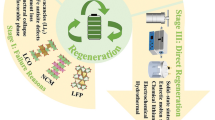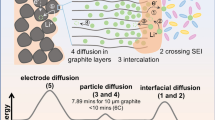Abstract
This research study focuses on the manufacturing of a bipolar plate used in proton exchange membrane fuel cells. In particular, the authors investigate the manufacturing of the part by means of warm hydroforming, adopting an aluminium alloy (AA6061) as sheet material. Both the channel profile (the reagent channel width and the die upper radius), and the bipolar plate geometries (in terms of channel layouts) are investigated by means of finite element simulations. Preliminary experimental investigations were carried out in order to define both the mechanical (flow curves) and strain behaviours (forming limit curves) of the adopted aluminium alloy according to temperature and strain rate. Subsequent finite element investigations aimed to define the channel profile by means of 2D models: a statistical approach was used to evaluate the dimension of the reagent channel width, the die upper radius and the sheet thickness. Finally, proposed bipolar plate geometries were investigated by running 3D simulations at different working temperatures and oil pressures in order to evaluate: (1) the bipolar plate geometry able to avoid regions with critical thinning and (2) suitable parameters for the warm hydroforming process.
Similar content being viewed by others
References
EG&G Technical Services, Inc. (2004) Fuel cell handbook (seventh edn). U.S. Department of Energy, Morgantown
Carton JG, Olabi AG (2010) Design of experiment study of the parameters that affect performance of three flow plate configurations of a proton exchange membrane fuel cell. Energy 35:2796–2806
Woodman AS, Anderson EB, Jayne KD, Kimble MC (1999) Development of corrosion-resistant coatings for fuel cell bipolar plates. Physical Sciences Inc., Andover, pp 1–9
Cunningham B (2007) The Development of compression moldable polymer composite bipolar plates for fuel cells. Ph.D. dissertation, Faculty of Virginia Polytechnic Institute and State University
Jeswiet J, Geiger M, Engel U, Kleiner M, Schikorra M, Duflou J, Neugebauer R, Bariani P, Bruschi S (2008) Metal forming progress since 2000. CIRP J Manuf Sci Technol 1:2–17
Dihrab SS, Sopian K, Alghoul MA, Sulaiman MY (2009) Review of the membrane and bipolar plates material for conventional and unitized regenerative fuel cells. Renew Sustain Energy Rev 13:1663–1668
Turan C, Cora ÖN, Koç M (2011) Effect of manufacturing processes on contact resistance characteristics of metallic bipolar plates in PEM fuel cells. Int J Hydrog Energy 36:12370–12380
Peker MF, Cora ÖN, Koç M (2011) Investigation on the variation of corrosion and contact resistance characteristics of metallic bipolar plates manufacturer under long-run conditions. Int J Hydrog Energy 36:15427–15436
Barranco F, Barreras A, Lozano MM (2011) Influence of Cr–N coating thickness on the corrosion resistance behaviour of aluminium-based bipolar plates. J Power Sources 196:4283–4289
Li D, Ghosh AK (2004) Biaxial warm forming behavior of aluminum sheet alloys. J Mater Process Technol 145(3):281–293
Li D, Ghosh A (2003) Tensile deformation behavior of aluminum alloys at warm forming temperatures. Mater Sci Eng A 352(1–2):279–286
Naka T, Torikai G, Hino R, Yoshida F (2001) The effects of temperature and forming speed on the forming limit diagram for type 5083 aluminum–magnesium alloy sheet. J Mater Process Technol 113:648–653
Masuda T, Kobayashi T, Wang L, Toda H (2003) Effects of strain rate on deformation behavior of A6061-T6 aluminum alloy. Mater Sci Forum 426–432:285–290
Zhang SH, Wang ZR, Xu Y, Wang ZT, Zhou LX (2004) Recent developments in sheet hydro-forming technology. J Mater Process Technol 151(1–3):237–241
Palumbo G, Pinto S, Tricarico L (2004) Numerical/experimental analysis of the sheet hydro forming process using cylindrical, square and compound shaped cavities. J Mater Process Technol 155–156(1–3):1435–1442
Mahabunphachai S, Koc M (2007) Feasibility investigations on a novel micro-manufacturing process for fabrication of fuel cell bipolar plates: Internal pressure-assisted embossing of micro-channels with in-die mechanical bonding. J Power Sources 172(2):725–733
Peng L, Lai X, Liu D, Hu P, Ni J (2008) Flow channel shape optimum design for hydroformed metal bipolar plate in PEM fuel cell. J Power Sources 178:223–230
Lang LH, Wang ZR, Kang DC, Yuan SJ, Zhang SH, Danckert J, Nielsen KB (2004) Hydroforming highlights: sheet hydroforming and tube hydroforming. J Mater Process Technol 151(1–3):165–177
Mahabunphachai S, Koc M (2010) Investigations on forming of aluminum 5052 and 6061 sheet alloys at warm temperatures. Mater Des 31:2422–2434
Johansson M, Hornqvist M, Karlsson B (2006) Influence of temperature and strain rate on the plastic deformation of two commercial high strength Al alloys. Mater Sci Forum 519–521:841–846
International Standard ISO 12004-2 Metallic material sheet and streep-determination of forming-limit curves—part2: determination of forming limit curves in the laboratory. First edition 15-10-2008
Bunge HJ, Pöhlandt K, Tekkaya AE, Banabic D (2000) Formability of metallic materials. Springer, Berlin
Djvanroodi D (2010) Experimental and numerical evaluation of forming limit diagram for Ti6Al4V titanium and AA6061-T6 alumnium alloys sheets. Mater Des 31:4866–4875
Gedikli H, Cora ON, Koç M (2010) Comparative investigations on numerical modeling for warm hydroforming of AA5754-O aluminum sheet alloy. Mater Des 32:2650–2662
Kumar A, Reddy RG (2003) Effect of channel dimensions and shape in the flow-field distributor on the performance of polymer electrolyte membrane fuel cells. J Power Sources 113:11–18
Palumbo G, Montemurro M (2011) Warm hydroforming of an aluminium bipolar plate for proton exchange membrane fuel cells. In: 10th International Conference on Technology of Plasticity-ICTP, Aachen, Germany, pp. 449–454. ISBN 978-3-514-00784-0
Groche P, Huber R, Dörr J, Schmoeckel D (2002) Hydromechanical deep-drawing of aluminium-alloys at elevated temperatures. CIRP Ann Manuf Technol 51(1):215–218
Author information
Authors and Affiliations
Corresponding author
Rights and permissions
About this article
Cite this article
Palumbo, G., Piccininni, A. Numerical–experimental investigations on the manufacturing of an aluminium bipolar plate for proton exchange membrane fuel cells by warm hydroforming. Int J Adv Manuf Technol 69, 731–742 (2013). https://doi.org/10.1007/s00170-013-5047-1
Received:
Accepted:
Published:
Issue Date:
DOI: https://doi.org/10.1007/s00170-013-5047-1




